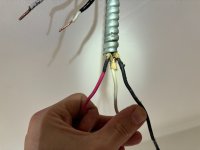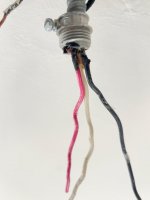Hey folks,
I was replacing a smoke alarm on a job and noticed charred insulation on some conductors in the (overfilled) ceiling box, and evidence of some arcing. I pulled a nearby luminaire and found the same thing - box was overfilled and two conductors were charred with compromised insulation. Neither circuits were protected by AFCI.
Curious to get folks thoughts on potential causes here, especially since these circuits are not carrying high loads. The cables are 12 AWG BX, originally installed in the early 90s, and were properly terminated (i.e., anti-short bushings were used). My best guess is that 30+ year old insulation has become brittle, and is easily cracked when bent or moved, which is made worse by the box overfill.
Some photos attached...
Neil
I was replacing a smoke alarm on a job and noticed charred insulation on some conductors in the (overfilled) ceiling box, and evidence of some arcing. I pulled a nearby luminaire and found the same thing - box was overfilled and two conductors were charred with compromised insulation. Neither circuits were protected by AFCI.
Curious to get folks thoughts on potential causes here, especially since these circuits are not carrying high loads. The cables are 12 AWG BX, originally installed in the early 90s, and were properly terminated (i.e., anti-short bushings were used). My best guess is that 30+ year old insulation has become brittle, and is easily cracked when bent or moved, which is made worse by the box overfill.
Some photos attached...
Neil



